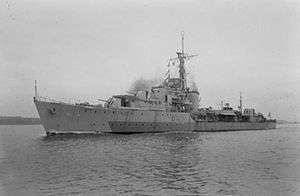HMS Chaplet (R52)
 HMS Chaplet on completion, 13 August 1945 | |
| History | |
|---|---|
| Name: | HMS Chaplet |
| Ordered: | 24 July 1942 |
| Builder: | Thornycroft, Woolston |
| Laid down: | 29 April 1943 |
| Launched: | 18 July 1944 |
| Commissioned: | 24 August 1945 |
| Identification: | Pennant number: R52 later changed to D52 |
| Fate: | Arrived for scrapping at Hughes Bolckow, Blyth on 6 November 1965 |
| General characteristics | |
| Class and type: | C-class destroyer |
| Displacement: | 1710 tons[1] |
| Length: | 362.75 ft (110.57 m)[1] |
| Beam: | 35.66 ft (10.87 m)[1] |
| Draught: | 10 ft (3.0 m) (mean), 16 ft (4.9 m) (max.)[1] |
| Installed power: | 40,000 hp (30,000 kW) |
| Propulsion: | Parsons geared turbines, 2 shafts; 2 Admiralty 3-drum type boilers[1] |
| Speed: | 36 knots (67 km/h; 41 mph) |
| Complement: | 186 |
| Armament: |
|
HMS Chaplet was a C-class destroyer of the Royal Navy that was in service from August 1945, and which was scrapped in 1965.
Construction
The Royal Navy ordered Chaplet on 24 July 1942, one of eight "Ch" subclass "Intermediate" destroyers of the 1942 Programme. She was laid down at the yard of Thornycroft, Woolston on 29 April 1943 and commissioned on 24 August 1945, too late for service in the Second World War.
Service
Chaplet was assigned to the 1st Destroyer Squadron based at Malta in the early 1950s. She was given an interim modernization in 1954, which saw her 'X' turret at the rear of the ship replaced by two Squid anti-submarine mortars.[2] She saw duty during the Suez Crisis in 1956.
Decommissioning and disposal
Chaplet was decommissioned and laid up in 1961. She was sold for scrapping to Hughes Bolckow and arrived at their yard at Blyth on 6 November 1965.
References
Publications
- Colledge, J. J.; Warlow, Ben (2006) [1969]. Ships of the Royal Navy: The Complete Record of all Fighting Ships of the Royal Navy (Rev. ed.). London: Chatham Publishing. ISBN 978-1-86176-281-8. OCLC 67375475.
- Marriott, Leo (1989). Royal Navy Destroyers Since 1945. Ian Allen Ltd. ISBN 0-7110-1817-0.